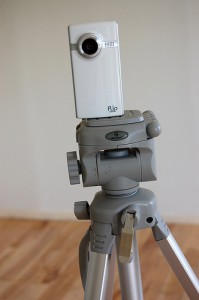 When all hell is breaking loose, they say, the best camera to shoot with is the one you have on hand. And one lesson we’ve all learned from YouTube is that technical quality doesn’t matter all that much when it comes to newsworthy video. That said, it’s always worth the effort to capture the best video possible under the circumstances, whether you’re shooting with a cell phone or a pocket-sized digital camera.
When all hell is breaking loose, they say, the best camera to shoot with is the one you have on hand. And one lesson we’ve all learned from YouTube is that technical quality doesn’t matter all that much when it comes to newsworthy video. That said, it’s always worth the effort to capture the best video possible under the circumstances, whether you’re shooting with a cell phone or a pocket-sized digital camera.
Tip number one: Keep the camera steady. Shaky video is hard to watch but that’s what you get from a lot of these small, lightweight cameras. The good news is that they all have a threaded tripod mount, so use it. Yes, it may look silly when you perch a Flip on a full-sized tripod, but it works. A flexible “gorillapod” is also handy to have. They weigh almost nothing and can be attached to lots of surfaces. If you have neither, rest the camera on a wall or the back of a chair to keep it steady.
Tip number two: Avoid the zoom at all costs. While most of these cameras have zoom lenses, they’re absolutely worthless. You can’t zoom smoothly with any of them and when you are zoomed in, the video quality goes from marginal to unacceptable. If you want a tighter shot, zoom with your feet.
Tip number three: Get close to get decent audio. If your camera has an external mic input, by all means use it. Many of them don’t, so they’ll only capture half-decent audio if you get close to the source. If you’re doing an interview, try to find a quiet spot.
A few additional tips: Keep your camera charged and/or carry spare batteries. These little cameras can be power hogs and they don’t always warn you when they’re getting low. Download what you’ve shot and clear your memory card on a regular basis. Video takes up way more space than still photos, so it’s also a good idea to carry a spare memory card.
Finally, this may seem obvious, but make sure you know how to use the camera before you actually need to. The Flip and its ilk are simple enough, but it can take a few steps to get some cell phones and still cameras into video mode.
The basics of shooting video are the same no matter what camera you use. For beginners or anyone who teaches them, here’s a useful recap from the BBC college of journalism:









4 Comments
I use a Droid phone to send breaking news video back from areas where our live truck cant reach. I had to construct a bracket for it that mounts right on the light shoe of my regular camera so I can take breaking video while im shooting regular news video for later use. For breaking news situtations, the Droid and its camera does fine.
I’ve seen that bracket idea in use elsewhere, Steve. The station adapted cell phone car cradles and mounted them on all field cameras so it could live stream events. The downside always seems to be the audio. Is that a problem with the Droid?